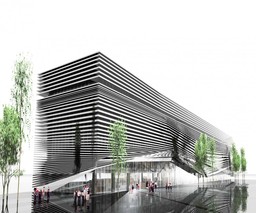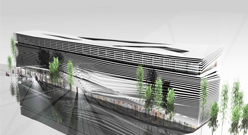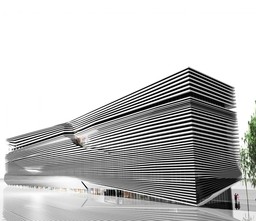-
- 16 NovKas Oosterhuis keynote speaker at SCALELESSSEAMLESS - International Symposium on integrated planning processes
- 14 Nov McNeel Hackfest in protoSPACE
- 12 OctFabrication Based Design and RhinoVAULT workshop
- 11 OctBook launch presentation: Hyperbody, First Decade of Interactive Architecture
- 30 AugHenriette Bier @ Blankensee-Colloquium 2012 on Neighborhood Technologies
- 29 JunMSc1 reNDSM Design Studio Final Reviews @ NDSM loods
- 23 MayLunch Lecture by ROK partners Silvan Oesterle and Matthias Rippman
- 07 MayLecture: Digital Prototyping by Jeroen van Ameijde
- 07 MayHot-Cold Transition Workshop, protoSPACE, 7th - 12th of May 2012
- 23 AprLecture: Cognition, People and Design
-
-

- Courtesy of Alireza Mahdizadeh Hakak, Ali Aleali, & Fatemeh Farmanfarmayee
Reaching the goals of Hyperbody in creating Non-standard buildings and adding the compatibility with LEED qualifications and meeting construction confinements, Alireza Hakak PhD candidate of Hyperbody has won an open competition. Hakak and his team were challenged to design a 10,000m2 commercial center for building industry in the Gilan Province, which is located in the northern part of Iran. Within a moderate climate and surrounded with forests, enough precipitation and unique landscape scenes are the main characteristics of the site.
Specific site dimension (150*20), building codes and regulation forced designer to extend the footprint through an east/west extension. To reach the final square meter, minimizing the voids and atriums was considered. However spotting two atriums for structural purposes meant that building respiration seemed to be necessary.
Flooded with environmentally conscious and LEED compliant, choices were implemented in energy efficiency (using the most natural ventilation and light by helping infiltration of the light and fresh air through elevation and roof), renewable energy (applying solar cells), water efficiency (designing a system for gathering waste water and recycle it for reuse), air quality (considering two atriums for natural light and ventilation) and usage of rapidly renewable resource (applying wood as a renewable resource for the second skin of building for climate and sound isolation).
The conference room, restaurant and other facilities shifted to the top floor not to interfere with commercial parts, also to get the advantages of the best view. Following the emergency exit regulations, three separate vertical accesses (staircase and elevators) been considered, starting from the top floor to the safe zones. Inside escalators will help the vertical access especially in the commercial spaces.
Seen from outside, the building seems to be formed by invisible forces of nature and actually deform the envelope. On one hand, we follow building codes and construction regulation and use the full capacity of the allowed footprint to reach the optimum square meters tp dictate the cubic simple shape. On the other hand, destructive forces and dissonances are at work which fragment the choreography of the monument and shaped the skin.
Architects: Alireza Mahdizadeh Hakak, Ali Aleali, Fatemeh Farmanfarmayee
 Facebook/
Facebook/
 Twitter/
Twitter/
 RSS
RSS


